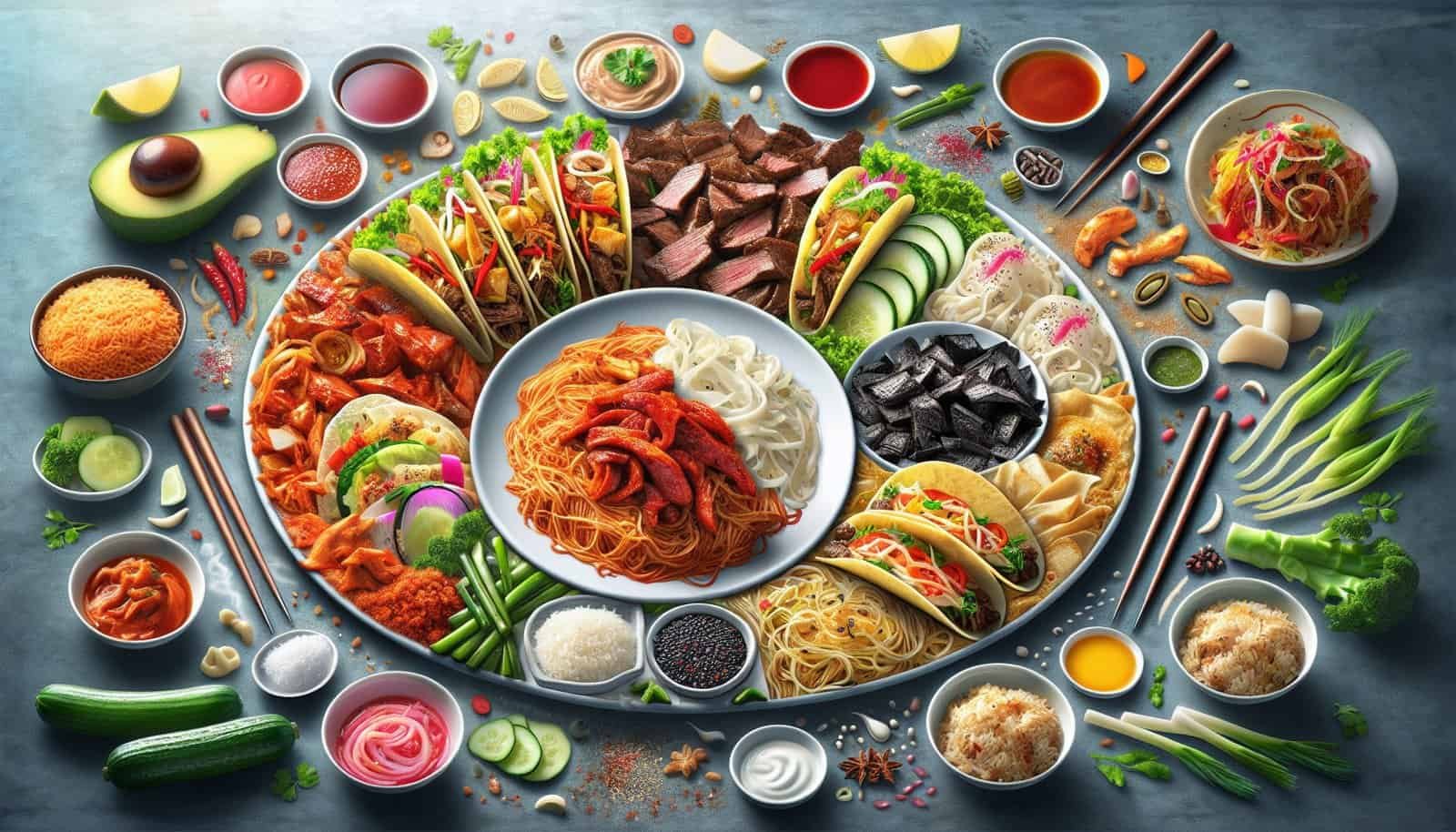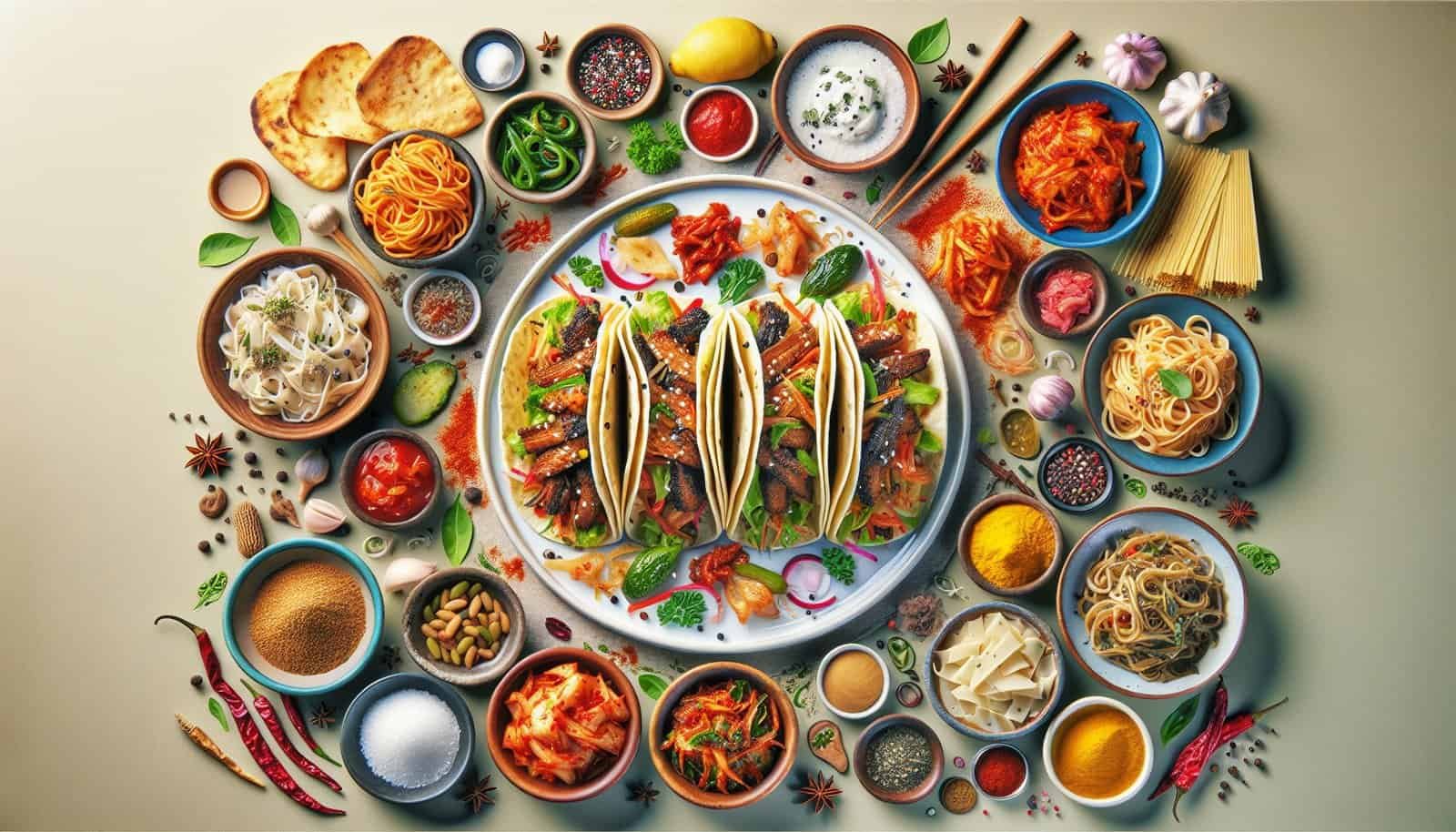In the ever-evolving world of global cuisine, the incorporation of Korean flavors has become a noteworthy trend. From the spicy kick of gochujang to the umami richness of kimchi, these unique flavors have captivated the taste buds of food enthusiasts worldwide. In this article, we will explore the current trends surrounding the infusion of Korean flavors into various international dishes. Whether you’re a food lover wanting to experiment in your own kitchen or simply curious about the latest culinary fusions, this article will offer insights into the exciting world of Korean-infused global cuisine. So grab a seat and get ready to embark on a flavorful journey like no other!

Traditional Korean Flavors
Korean cuisine is known for its bold and unique flavors, and one of the key elements that sets it apart is the extensive use of fermented ingredients. Fermentation not only enhances the taste and aroma of the ingredients but also offers numerous health benefits. From the iconic kimchi, made from fermented cabbage and chili paste, to other traditional dishes such as doenjang (fermented soybean paste) and ganjang (soy sauce), the use of fermented ingredients is deeply ingrained in Korean cooking.
Another hallmark of Korean cuisine is the ssam culture, which refers to the act of wrapping food in lettuce or other leafy greens. This not only adds freshness and texture to the dish but also allows for a customizable dining experience. Ssam can be enjoyed with a variety of fillings, such as grilled meat, tofu, or even fermented vegetables. The combination of different flavors and textures makes for a satisfying and interactive meal.
One of the most renowned Korean condiments is gochujang, a fermented chili paste that adds a spicy kick to many dishes. Gochujang has gained popularity worldwide due to its versatility and depth of flavor. It can be used as a marinade for meat, a base for sauces and dressings, or even mixed into stews and soups to add a rich and complex taste. Its unique combination of sweetness, spiciness, and umami flavors has made gochujang a staple in many kitchens around the world.
Bibimbap, which translates to “mixed rice,” is another iconic Korean dish that showcases a harmonious blend of flavors. It typically consists of a bowl of rice topped with an assortment of vegetables, protein (such as bulgogi or tofu), and a fried egg, all drizzled with gochujang sauce. The diverse ingredients not only provide a vibrant color palette but also offer a balance of textures and flavors. It’s a wholesome and satisfying meal that can be customized to suit individual preferences.
No discussion of traditional Korean flavors would be complete without mentioning kimchi. Considered a national dish in Korea, kimchi is a fermented side dish made with cabbage or radishes, garlic, ginger, and chili paste. It is often enjoyed as a side dish, but it can also be incorporated into various recipes, such as kimchi fried rice or kimchi stew. With its tangy, spicy, and slightly sour taste, kimchi adds depth and complexity to any dish it accompanies.
Adaptation of Korean Ingredients and Techniques
The popularity of Korean cuisine has sparked a wave of culinary innovation, resulting in the adaptation of Korean ingredients and techniques in global cuisine. One prime example is Korean Fried Chicken (KFC), which has gained a cult following around the world. Korean fried chicken differs from its American counterpart in that it is typically double-fried, resulting in an irresistibly crispy and flavorful coating. The chicken is then coated in a variety of sauces, such as spicy gochujang or sweet and tangy soy garlic, showcasing the versatility of Korean flavors.
Another popular adaptation is Korean BBQ fusion, which combines the tradition of grilling meat at the table with flavors from different cuisines. Korean BBQ fusion often involves marinating the meat in a Korean-inspired sauce, such as bulgogi or kalbi, and then incorporating it into dishes such as tacos, sliders, or even pizza. The marriage of Korean BBQ flavors with other culinary traditions creates a unique and exciting dining experience.
Korean tacos have also gained traction in recent years, fusing the flavors of Korean cuisine with the portable and customizable nature of Mexican street food. Fillings such as bulgogi, spicy pork, or tofu are wrapped in a tortilla and topped with fresh vegetables, spicy sauces, and even kimchi. The result is a combination of textures and flavors that tantalize the taste buds and offer a refreshing twist on traditional tacos.
Not to be overlooked, Korean ramen has made a significant impact on global cuisine. Korean ramen typically features a spicy broth flavored with gochujang or kimchi, accompanied by various toppings such as sliced beef, vegetables, and a soft-boiled egg. The fusion of Korean flavors with the comfort of a classic noodle dish has resulted in a popular and satisfying meal for people of all backgrounds.
Korean pizza is another example of how Korean ingredients and techniques have been adapted in global cuisine. Unlike traditional Italian-style pizza, Korean pizza often features unique toppings such as sweet potato, corn, or even bulgogi. The crust is typically thicker and chewier, offering a different texture and mouthfeel. Korean pizza embraces the bold and unconventional, providing a playful and delicious twist on a classic dish.
K-Fusion Cuisine
Korean cuisine’s influence extends beyond individual dishes; it has inspired a whole new genre of fusion cuisine known as K-Fusion. K-Fusion combines Korean flavors and ingredients with culinary traditions from other parts of the world, resulting in innovative and exciting creations.
One popular example of K-Fusion is Korean-Mexican fusion, which blends the bold flavors of Korean cuisine with the vibrant and spicy elements of Mexican fare. Korean-Mexican tacos often feature fillings such as bulgogi or kimchi-infused proteins, topped with traditional Mexican condiments like salsa, guacamole, and cilantro. The fusion of these two cuisines creates a harmonious blend of flavors that take taste buds on a culinary adventure.
Korean-Japanese fusion, also known as “Korean-Japanada,” combines elements from both cuisines to create unique and delightful dishes. One example is the Korean-style sushi roll, which incorporates Korean flavors such as spicy gochujang sauce or pickled vegetables into traditional Japanese sushi. The result is a marriage of delicate Japanese techniques with bold Korean flavors, offering a new twist on beloved sushi rolls.
Korean-Italian fusion, or Itaewon cuisine, draws inspiration from the vibrant food scene in Seoul’s Itaewon district. This fusion combines the simplicity and elegance of Italian dishes with the bold and spicy flavors of Korean cuisine. Korean-Italian fusion dishes may include creations such as bibimbap-inspired risotto or pizza topped with bulgogi and kimchi. The combination of these contrasting flavors and culinary traditions creates a unique and innovative dining experience.
Korean-Hawaiian fusion takes the tropical flavors of Hawaii and combines them with the bold and spicy elements of Korean cuisine. This fusion can be seen in dishes such as Korean-style poke bowls, which feature marinated meat, fresh vegetables, and Korean sauces served over a bed of rice or salad. The result is a refreshing and flavorful meal that showcases the best of both cultures.
The influence of Korean cuisine has even reached the Middle East, resulting in Korean-Middle Eastern fusion dishes. This fusion combines Middle Eastern flavors such as hummus, tahini, and falafel with Korean spices and ingredients. Examples include dishes like bulgogi pita wraps or kimchi-spiced hummus. The marriage of these two culinary traditions offers a delightful juxtaposition of flavors and textures.
Health and Wellness Trends
As more people prioritize health and wellness in their lifestyles, there has been a growing demand for healthier food options that incorporate Korean flavors. Korean cuisine aligns well with these trends due to its emphasis on fresh ingredients, balanced flavors, and fermentation techniques, which offer various health benefits.
The rise of vegetarianism and veganism has led to an increased interest in vegetarian and vegan options in Korean cuisine. Traditionally, Korean cuisine includes many vegetable-based dishes, making it easier to adapt to a plant-based diet. Vegetarian and vegan versions of traditional dishes, such as bibimbap or tofu bulgogi, have become more widely available, allowing individuals to savor the flavors of Korean cuisine while adhering to their dietary preferences.
Superfoods have gained attention for their nutrient-rich profiles, and Korean cuisine has its fair share of superfoods. Fermented drinks like kombucha and makgeolli have gained popularity for their probiotic content and digestive benefits. Other superfoods commonly found in Korean cuisine include seaweed, ginseng, black garlic, and various types of mushrooms. Incorporating these ingredients into dishes not only adds extra nutrition but also enhances the overall flavor profile.
Traditional Korean medicinal ingredients, known as hanbang, have been a significant part of Korean culture for centuries. These ingredients, such as ginseng, jujube, and ginger, are believed to have various health benefits. Recently, there has been a resurgence in incorporating hanbang ingredients into modern Korean cuisine. Dishes like ginseng chicken soup and jujube tea have become popular choices for those seeking traditional medicinal benefits.
The demand for gluten-free options has also influenced the adaptation of Korean cuisine. Many Korean dishes naturally avoid gluten due to the reliance on rice, vegetables, and fermented ingredients. Rice-based dishes like bibimbap or gluten-free versions of popular dishes like japchae, made with sweet potato noodles, make Korean cuisine accessible to those with gluten sensitivities or dietary restrictions.
In response to concerns about excessive sugar and sodium consumption, there has been a push for low-sugar and low-sodium options in Korean cuisine. Restaurants and food manufacturers have begun offering reduced-sugar and reduced-sodium versions of traditional dishes, ensuring that individuals can enjoy the flavors of Korean cuisine without compromising their health goals.

Influence of K-Pop and Korean Pop Culture
K-Pop, an abbreviation for Korean pop music, has gained an immense following worldwide, and with it, there has been a significant influence on Korean food culture. This influence can be seen through the emergence of K-Pop-themed cafes and restaurants, K-Pop celebrity chef collaborations, and even the pairing of Korean drama with K-Food.
K-Pop-themed cafes and restaurants have become popular destinations for K-Pop enthusiasts and food lovers alike. These establishments often feature K-Pop memorabilia, themed decorations, and menus inspired by K-Pop stars or their favorite songs. From colorful drinks named after K-Pop idols to dishes inspired by their favorite music videos, these venues offer a unique and immersive experience that combines the worlds of food and entertainment.
K-Pop celebrities with a passion for cooking have also embraced the culinary world, leading to collaborations with renowned chefs. These collaborations often result in special menus or signature dishes that reflect the tastes and preferences of the K-Pop celebrities. It showcases the synergy between the artistry of music and the artistry of cooking, creating a fusion of flavors that resonate with fans and food enthusiasts alike.
Korean dramas, with their captivating storylines and beautiful cinematography, have gained a dedicated fan base around the world. In recent years, there has been a trend of pairing Korean dramas with K-Food, creating unique dining experiences that mirror the scenes and settings of beloved dramas. Themes like “secret garden” or “goblin’s bride” are incorporated into the menus, offering a sensory journey that brings together the emotions of the drama and the flavors of Korean cuisine.
Incorporating themed menus and dishes based on K-Pop or Korean pop culture has become a way for restaurants and cafes to tap into the enthusiasm of K-Pop fans and Korean drama lovers. It allows people to immerse themselves in the world of their favorite stars or dramas while enjoying the delicious flavors of Korean cuisine, creating memorable and enjoyable dining experiences.
Korean Street Food Inspiration
Korean street food is an essential part of Korean culinary culture, and its popularity has spread beyond the streets of Korea. Some iconic examples of Korean street food inspire creativity and innovation in global cuisine.
Tteokbokki, a beloved street food option, consists of chewy rice cakes cooked in a spicy gochujang-based sauce. This combination of flavors and textures has gained popularity, leading to adaptations in international cuisine. Tteokbokki-inspired dishes can be found in noodle bowls, stir-fries, or even as a topping for pizzas or hot dogs, showcasing the versatility and appeal of this traditional street food.
Japchae, a dish made with sweet potato noodles stir-fried with vegetables and protein, is another street food favorite that has become popular worldwide. The vibrant colors, addictive flavor, and satisfying texture of japchae make it a versatile dish that can be enjoyed on its own or used as a base for other creative recipes. Japchae’s presence has expanded to include variations like japchae burritos or japchae-inspired sushi rolls, bringing a taste of Korean street food to different culinary traditions.
Hotteok, a sweet Korean pancake filled with cinnamon-sugar, nuts, or even cheese, is a popular street food item that has captured the hearts and palates of many. Its combination of a crispy exterior and gooey, sweet filling has inspired the creation of various desserts worldwide. Hotteok-inspired pastries, muffins, or even ice cream flavors can be found, each offering a unique take on this delightful street food treat.
Bungeoppang, also known as Korean fish-shaped pastry, is a quintessential street food item that has gained a global following. The snack consists of a fluffy pancake-like batter filled with sweet red bean paste or other fillings like Nutella or cheese. In recent years, Bungeoppang has been reimagined as ice cream cones, donuts, or even as a topping for waffles, showcasing its versatility and appeal as a nostalgic and delicious treat.
Eomuk, a Korean fish cake often enjoyed as a street food snack, has found its way into various culinary creations worldwide. Eomuk-inspired dishes can include fish cakes as toppings on pizzas, sandwiches, or even in sushi rolls. The mild, savory flavor and soft, chewy texture of eomuk make it a versatile ingredient that complements a wide range of cuisines.

Fusion Desserts
Innovative and delicious desserts are not immune to the influence of Korean flavors, resulting in the emergence of fusion desserts that combine traditional Korean elements with international flavors.
Korean Bingsu, a shaved ice dessert traditionally topped with sweetened red beans and condensed milk, has become a canvas for culinary creativity. The base of shaved ice can be paired with a variety of toppings, such as fresh fruits, nuts, chocolate, or even matcha. This has led to the creation of bingsu with international flavors like mango, strawberry cheesecake, or even cookies and cream, offering a refreshing and indulgent treat with a Korean twist.
Korean-inspired ice cream flavors have gained popularity for their unique and intriguing taste profiles. Flavors like matcha, black sesame, and red bean bring a touch of Korean culinary tradition to the world of frozen treats. The creamy, rich textures and subtle yet distinct flavors create an enjoyable experience that resonates with both ice cream enthusiasts and fans of Korean cuisine.
Korean rice cakes, known as tteok, have found their way into Western desserts, adding a delightful twist to traditional sweets. Tteok can be incorporated into cakes, cookies, or even as a filling for pastries, infusing these desserts with a chewy and slightly sweet element. The combination of familiar desserts with the unique texture and flavor of tteok offers a pleasant surprise that captivates the taste buds.
Incorporating traditional Korean teas into desserts has become a popular trend. Korean teas, such as citron tea or barley tea, are known for their soothing and comforting qualities. They can be used to flavor cakes, cookies, or even ice cream, adding a distinct Korean touch and imparting these desserts with a subtle yet delightful flavor.
Mochi donuts with Korean twists have become a sought-after treat for those who appreciate the chewy and delicate texture of mochi. These donuts typically feature a rice flour-based dough that is fried until crispy on the outside, with a soft and chewy interior. Korean-inspired flavors, such as matcha or black sesame, are often used to add a unique twist to these mochi donuts, making them a delightful fusion of textures and flavors.
Korean Celebrity Chef Influence
The rise of Korean cuisine’s global popularity has also propelled Korean celebrity chefs into the limelight, resulting in their profound influence on the culinary world. Korean celebrity chefs have brought their unique perspectives, skills, and innovation to the forefront, leading to the emergence of innovative dining experiences and culinary collaborations.
Celebrity chef restaurants have become an essential part of the culinary landscape, with Korean chefs at the forefront. These restaurants showcase the culinary prowess of the chefs, as well as their dedication to preserving and elevating traditional Korean flavors. Celebrity chef restaurants often feature curated menus that offer a blend of classic Korean dishes and modern interpretations, providing a tantalizing fusion of flavors and taste experiences.
Korean celebrity chefs actively promote Korean cuisine on cooking shows, both domestically and internationally. Their presence on these shows allows them to share their knowledge, techniques, and love for Korean flavors with a global audience. Through these platforms, Korean chefs have become ambassadors for Korean cuisine, inspiring viewers to explore and experiment with Korean flavors in their own kitchens.
Incorporating Korean flavors into signature dishes has become a hallmark of Korean celebrity chefs, showcasing their creativity and ability to reimagine traditional flavors. These chefs often infuse classic dishes with Korean ingredients or incorporate Korean sauces, spices, or condiments to add a unique twist. The result is a harmonious fusion of culinary traditions that transcends boundaries and captivates the taste buds.
Culinary collaborations between Korean celebrity chefs and international chefs have become increasingly common, allowing for an exchange of culinary expertise and the fusion of diverse culinary traditions. These collaborations often result in special menus or events that feature a combination of flavors, techniques, and ideas from different parts of the world. The coming together of chefs from different backgrounds creates a dynamic and exciting culinary experience that celebrates the beauty of diversity.
Korean celebrity chefs often incorporate traditional Korean techniques with a modern twist, highlighting their ability to create innovative and visually stunning dishes. Traditional ingredients and cooking methods are combined with modern presentation styles, resulting in dishes that are not only delicious but also visually captivating. This blend of tradition and innovation has become a signature aspect of Korean celebrity chef influence on the culinary world.

Sustainability and Locally Sourced Ingredients
In recent years, there has been an increased focus on sustainability and the use of locally sourced ingredients in the culinary industry. Korean cuisine, with its emphasis on fresh and seasonal ingredients, aligns well with these trends and has embraced a farm-to-table philosophy.
Farm-to-table Korean cuisine promotes the use of locally sourced ingredients, reducing the carbon footprint associated with transportation and supporting local farmers and artisans. By sourcing ingredients from nearby farms and producers, restaurants can ensure the freshness and quality of their dishes while promoting sustainability. This commitment to local ingredients also allows for a deeper connection to the surrounding community and the preservation of culinary traditions.
Foraging for wild Korean ingredients has also gained traction, allowing chefs to incorporate indigenous flora and fauna into their dishes. Korean cuisine has a rich tradition of foraging for wild greens, mushrooms, and other seasonal ingredients. By incorporating these foraged ingredients, restaurants can offer unique and flavorful dishes while promoting the preservation of local ecosystems.
Utilizing sea vegetables and seafood in Korean cuisine showcases a commitment to sustainability and the protection of marine ecosystems. Korean cuisine features a wide variety of sea vegetables such as seaweed, kelp, and sea mustard. These ingredients not only add depth of flavor and nutrition to dishes but also promote sustainable harvesting practices and the cultivation of marine resources.
Supporting local farmers and artisans is a key aspect of sustainability in Korean cuisine. By purchasing ingredients from local farmers, restaurants can support the local economy and reduce the environmental impact associated with large-scale industrial farming. Similarly, promoting the work of local artisans, such as pottery makers or traditional food producers, helps preserve cultural heritage and traditional craftsmanship.
Korean Alcoholic Beverages
Korean culture has a rich tradition of alcoholic beverages, many of which have gained popularity beyond Korea’s borders. These beverages offer unique flavors and taste experiences for those looking to explore Korean cuisine and culinary traditions.
Traditional rice wine, known as makgeolli, has a milky appearance and a sweet yet tangy taste. Makgeolli has gained popularity internationally due to its unique flavor profile and versatility. It can be enjoyed on its own or mixed with various fruit juices to create refreshing cocktails. The rise in interest and appreciation for artisanal and craft beverages has also led to a resurgence of traditional makgeolli brewing methods and the exploration of different flavor variations.
Soju, Korea’s most popular distilled alcoholic beverage, has also made its mark on the global stage. Traditionally made from rice, soju has a milder taste compared to other spirits. Soju is commonly enjoyed neat or mixed with other beverages to create refreshing cocktails. Its versatility and affordability have made it a popular choice for social gatherings and celebrations both in Korea and abroad.
Korean craft beers have emerged as a trend in the global craft beer scene. Craft breweries in Korea are experimenting with unique flavor combinations, using traditional Korean ingredients such as ginseng or makgeolli in their recipes. These beers offer a refreshing alternative to traditional beer styles and showcase the innovation and creativity of Korean brewers. With the rise of the craft beer movement, Korean craft beers have gained recognition and appreciation from beer enthusiasts around the world.
Korean-style cocktails, inspired by traditional flavors and ingredients, have become a popular choice for those seeking a unique and refreshing drinking experience. These cocktails often incorporate traditional Korean spirits such as soju or makgeolli and pair them with fresh fruits, herbs, or Korean-inspired syrups. The result is a fusion of international cocktail culture with Korean flavors, offering an exciting twist on classic cocktails.
Fruit-infused soju has gained popularity as a flavorful and refreshing alternative to traditional soju. Various fruits such as watermelon, pineapple, or grapefruit are sliced and soaked in soju, resulting in a fruity and aromatic beverage. Fruit-infused soju is a popular choice for casual social gatherings and appeals to those who prefer a sweeter taste profile.
In conclusion, the incorporation of Korean flavors into global cuisine is a vibrant and exciting trend that continues to evolve. From traditional Korean flavors and ingredients to fusion creations, Korean cuisine offers a wealth of culinary opportunities for chefs and food enthusiasts alike. Whether it’s through the adaptation of street food, fusion desserts, or the influence of K-Pop and Korean pop culture, the impact of Korean flavors on global cuisine is undeniable. As the world becomes increasingly interconnected, the exploration and fusion of diverse culinary traditions will only continue to thrive, creating a rich tapestry of flavors and experiences.

